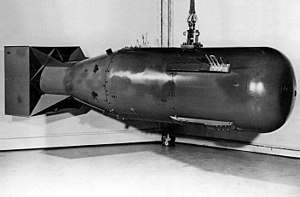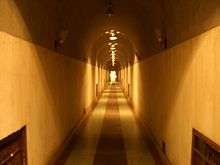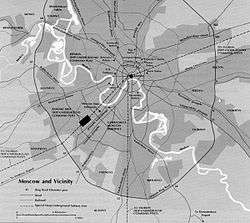Continuity of government
Continuity of government (COG) is the principle of establishing defined procedures that allow a government to continue its essential operations in case of a catastrophic event such as nuclear war.
| Nuclear weapons |
|---|
 |
| Background |
| Nuclear-armed states |
|
COG was developed by the British government before and during World War II to counter threats, such as that of the Luftwaffe bombing during the Battle of Britain. The need for continuity of government plans gained new urgency with nuclear proliferation.
During and after the Cold War countries developed such plans to avoid (or minimize) confusion and disorder due to a power vacuum in the aftermath of a nuclear attack.
In the US at least, COG is no longer limited to nuclear emergencies; the Continuity of Operations Plan was activated following the September 11 attacks.
By country
Canada
Canada built numerous nuclear bunkers across the country, nicknamed "Diefenbunkers" in a play on the last name of then-Prime Minister John Diefenbaker. In 2016, the Privy Council Office made an agreement with the Department of National Defence to open two bunkers for government officials amid the ongoing North Korean nuclear crisis.[1]
China/People's Republic of China

The People's Republic of China (PRC) once operated Underground Project 131, intended to be the PLA headquarters in Hubei during a nuclear conflict. Built due to the Sino-Soviet split during that portion of the Cold War, in 1981, the Project 131 site was turned over to the civilian authorities of the prefecture-level city of Xianning, where it is located.
Czech Republic
The K-116 facility under Zlíchov hill in western Prague was designated to house the Czechoslovak government in case of nuclear attack (together with the K-9 facility in Jihlava) and might still be used as the emergency headquarters of the Czech government and military.[2]
Denmark
During the Cold War, Denmark built two bunker complexes, named REGAN Vest and REGAN Øst (Danish: "REGeringsANlæg", translated: "Government Complex West and Government Complex East"), in Jutland and Zealand respectively. The idea was to have half of the government and the royal family in one bunker, and the other half in the other, allowing continuity of government, even if one of the bunkers were destroyed or cut off.
France
The Centre d'opération des forces aériennes stratégiques (COFAS) is a hardened command centre for French nuclear forces at Taverny Air Base in Taverny, Val d'Oise. The alternate national command center is located at Mont Verdun near Lyon.
The hardened headquarters of Force océanique stratégique (FOST), France's nuclear SSBN fleet, is at Houilles, Yvelines.
Germany
Germany operated a government bunker (Regierungsbunker) to house the German government, parliament and all federal personnel needed to keep the government working in the event of war or severe crisis. It was decommissioned in 1997.
Republic of Ireland
In Ireland, the National Security Committee (NSC) is the conduit for officials to communicate with the Taoiseach (Prime Minister) and/or cabinet members if the normal channel of communication with their minister became unavailable. Drafts of emergency powers legislation have been drawn up in secret, including legislation to deal with circumstances such as an attack on cabinet involving numerous deaths.[3]
During the period of the Cold War, it was envisaged that cabinet ministers, senior civil servants and military advisers would use an underground nuclear bunker at Custume Barracks in Athlone in the event of a nuclear exchange. The bunker was equipped with a command and control centre with communications equipment – which had a hotline to the British government in Whitehall – a map room pointing out important areas for protection, kitchen, bedroom and bathroom facilities.[4][5]
Israel
As of December 2003 an underground national crisis management center was being constructed at an undisclosed location in the Judaean Mountains under Jerusalem.[6][7] Another command and control bunker is being built as part of the new Prime Minister's Office complex in Givat Ram.[8]
New Zealand
The New Zealand government believes the most likely disaster scenario to affect the government is a large earthquake in Wellington. The government has plans to move Parliament and essential staff to Devonport Naval Base in Auckland if such an event occurs.[9]
Norway
The Norwegian government operates a nuclear bunker called Sentralanlegget in Buskerud County. The bunker is meant to accommodate the Norwegian Royal Family and the government in case of a nuclear/military attack on the nation, and also function as a wartime headquarters. There is also a bunker beneath Høyblokka in downtown Oslo.
Soviet Union and Russia
Very little, in the public domain, is known about Russia's COG plans. One sprawling underground facility residing in tunnels cut into Mount Yamantau is likely to be related to the survival of Russia's government, given its size and decades long construction history, with a construction start during the rule of Leonid Brezhnev (1964–82).[11] KGB defector Colonel Oleg Gordievsky states that an organization, known as Directorate 15, was (or is) tasked with building and maintaining a network of hundreds of underground command bunkers for the Soviet leadership; this includes the vast site beneath Yamantau Mountain, which is often called Mezhgorye / Межго́рье after the closed city that is located nearby. However, there is speculation, due to its proximity to Chelyabinsk-70, that Yamantau is a 400-square-mile underground complex which houses nuclear warheads, missiles, launch controls, and several nuclear weapons factories designed to continue production after a hypothetical nuclear war begins.[12]
The second command and control center in the Urals, after Yamantau, is similarly speculated to be underground and located near, or under, Kosvinsky Kamen. The site is believed to host the Russian Strategic Rocket Forces alternate command post, a post for the general staff built to compensate for the vulnerability of older Soviet era command posts in the Moscow region. In spite of this, the primary command posts for the Strategic Rocket Forces remains Kuntsevo in Moscow and the secondary is the Kosvinsky Mountain in the Urals.[13] The facility at Kosvinsky, finished in early 1996, was designed to resist US earth-penetrating warheads and serves a similar role as the American Cheyenne Mountain Complex.[12]
Further command centers, according to globalsecurity.org, include one near Chekhov, which is the Russian General Staff wartime command post, buried deep underground,[14] and Sharapovo(ru) about 80 kilometres (50 mi) south of Moscow, built in the 1950s, Sharapovo is believed to have been the primary backup command center for the Soviet era leadership. Both Chekhov and Sharapovo are each suggested to have the capability to accommodate about 30,000 individuals,[12] As an alternative to Sharapovo, a secondary political leadership base is located at Chaadayevka, some 650 kilometers southeast of Moscow near the city of Penza.[15]
There is also said to be as many as 12 underground levels beneath the Russian capital of Moscow to protect the government in the Kremlin, known as the Main Directorate of special programs of the President (Glavnoye Upravlenie Specialnih Program: GUSP) (ru) the direct successor of the 15th Directorate of the KGB, which was established in 1977, GUSP is said to oversee, amongst other sites, a parallel track line alongside the Moscow metro, known as the 'Kremlin line' Metro-2 or D-6 to be used in an emergency.[16] Two destinations of this system are suggested to be the old KGB headquarters, now the FSB headquarters, at Lubyanka Square, and the second being regarded as an enormous underground leadership bunker adjacent to Moscow State University.[10] Another alleged subterranean destination, apart from the aforementioned underground town at Ramenki/Moscow State University is Vnukovo-2 airport.[17] Despite official Russian state ambiguity, it is speculated that many of the Moscow bunkers are linked by an underground railway line.[12]
Sweden
During the Cold War, the Klara skyddsrum ("Klara shelter" or "Klara bunker") was built underneath Stockholm. The bunker is designed to accommodate two thirds of the government and between 8,000 and 12,000 civilians in the case of a military attack on Stockholm. It is designed as a very large, two-story oval, with multiple entrances. During peacetime, parts of it are used as a parking garage. Sweden built over 65,000 fallout shelters[18] in regular houses, and every county had at least one large hard-rock underground bunker that controlled a number of smaller bunkers that were located in the municipalities.[19]
Turkey
There is little public knowledge about continuity of government in Turkey. The cabinet and presidential offices, based in the capital of Ankara, have secondary sites in İstanbul and İzmir.
United Kingdom
The primary British COG headquarters is at the Ministry of Defence in Whitehall. The Central Government War Headquarters was previously maintained in a quarry complex near Corsham, Wiltshire. The above-ground support facility was RAF Rudloe Manor.
Service command centres are Northwood for the Royal Navy Trident SSBN force, and RAF High Wycombe for the Royal Air Force.
United States
Continuity of the national government was first threatened in late 1776, when British forces advanced toward the Continental capital at Philadelphia. On December 9 the Continental Congress passed a resolution in anticipation of a British capture:
- Resolved: That in case this Congress shall be under the necessity of removing from Philadelphia, it shall be adjourned to Baltimore.
The Congress was adjourned as planned three days later.[20] Other relocations followed during the course of the Revolutionary War.
For most of its existence, the United States operated without a standing continuity plan. When British forces burned Washington in 1814, Secretary of State James Monroe received only a few hours' notice to remove the government records. Although his staff saved many valuable records, much was nonetheless destroyed, and the next administration encountered a great deal of confusion.[21]
In 1952 President Truman ordered all federal offices to develop their own continuity plans for the event of a civil defense emergency. Plans have been maintained and adapted since then, at times requiring the construction of secret facilities such as the emergency Congress facility in Greenbrier County, West Virginia. The current continuity policy is defined in National Security Policy Directive 51[22] and its implementation plan.[23] The continuity plan was activated for the first time during the September 11, 2001 attacks.[24]
See also
- Critical Infrastructure Protection
- Decapitation strike
- Disaster recovery
- Government in exile
- Shadow government (disambiguation)
- Temporary capital
- Minimum viable population: 4000-5000 unrelated individuals
UK-specific:
US-specific:
- Continuity of Government Commission
- Continuity of Operations Plan
- Designated survivor
- National Security and Homeland Security Presidential Directive
- Wartime Information Security Program
- Senate Report 93-549
- Federal Emergency Management Agency
References
- "Archived copy". Archived from the original on January 14, 2018. Retrieved 2017-11-30.CS1 maint: archived copy as title (link) CS1 maint: BOT: original-url status unknown (link)
- "Kam by se ukryli komunističtí funkcionáři před třetí světovou válkou?" [Where would communist functionaries hide in case of world war III?] (in Czech).
- Mulqueen, Michael (2009). Re-evaluating Irish national security policy : affordable threats?. Manchester: Manchester University Press. ISBN 978-0-7190-8027-2.
- "Waking up to a nuclear nightmare..." Irish Independent. 31 July 2004. Retrieved 29 October 2016.
- De Breadun, Deaglan (3 January 2003). "Memo reveals plans for nuclear bunker". The Irish Times.
- ynet (2003-07-12). "הבור בירושלים: מכאן תנוהל המדינה בשעת חירום". Ynet (in Hebrew). Retrieved 2019-01-03.
- אילני, עפרי (2010-09-07). "זה לא סוף העולם". הארץ (in Hebrew). Retrieved 2019-01-03.
- "תיעוד בלעדי: כך נראה מהאוויר המקום ממנו ינהל רה"מ את המלחמה הבאה" (in Hebrew). ערוץ 10. Retrieved 2019-01-03. Check date values in:
|date=(help) - Davison, Isaac (8 May 2014). "Parliament would relocate to Auckland if quake knocked out capital". NZ Herald. Retrieved 8 May 2014.
- United States Department of Defense (1991). Military forces in transition. Washington, D.C.: United States Department of Defense. p. 40. ISBN 0-16-035973-2. ISSN 1062-6557. Retrieved 2011-06-13.
- Gordon, Michael R. (April 16, 1996). "Despite Cold War's End, Russia Keeps Building a Secret Complex" – via NYTimes.com.
- "WINDOW ON HEARTLAND Geopolitical notes on Eastern Europe, the Caucasus and Central Asia". Archived from the original on April 24, 2013.
- Globalsecurity.org, Strategic C3I Facilities, accessed October 2007
- Globalsecurity.org. Chekhov.
- "Chaadayevka". www.globalsecurity.org.
- "The Main Directorate of special programs of the President, the GUSP Chief - Alexander Tsarenko".
- "Secrets 'Metro'-Style". www.globalsecurity.org.
- https://www.thelocal.se/20171101/why-sweden-is-home-to-65000-fallout-shelters
- Fall, Anders (January 31, 2017). "Hemlig bunker i Halmstad öppnades" – via www.svt.se.
- Journals of the Continental Congress
- "Staffing and Administration - Short History - Department History - Office of the Historian". history.state.gov.
- "NSPD-51: National Continuity Policy". fas.org.
- http://www.fema.gov/media-library-data/1384886826028-729844d3fd23ff85d94d52186c85748f/NCPIP.pdf
- Gellman, Barton; Schmidt, Susan (1 March 2002). "Shadow Government Is at Work in Secret" – via washingtonpost.com.
External links
- Washington Post article - Back to the Bunker
- CBS News Article - 'Shadow Government' News to Congress
- Video: COVER UP - Behind the Iran Contra Affair - Pt 3 specifically, also Pt 1 Pt 2
- Summary of Executive Powers
- Congressman DeFazio denied access to Continuity of Government files
- Spencer S. Hsu, "Bush Changes Continuity Plan: Administration, Not DHS, Would Run Shadow Government," Washington Post, May 10, 2007; Page A12.
